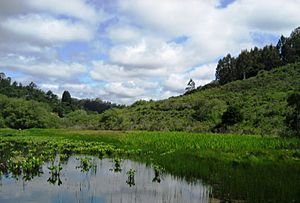Ellicott Slough National Wildlife Refuge facts for kids
Quick facts for kids Ellicott Slough National Wildlife Refuge |
|
|---|---|
|
IUCN Category IV (Habitat/Species Management Area)
|
|

Calabasas Pond
|
|
| Location | Santa Cruz County, California, United States |
| Nearest city | Watsonville, California |
| Area | 168 acres (0.68 km2) |
| Established | 1975 |
| Governing body | U.S. Fish and Wildlife Service |
| Website | Ellicott Slough National Wildlife Refuge |
The Ellicott Slough National Wildlife Refuge is a special natural area in California, in the northern part of the Monterey Bay region. It's like a protected home for many different animals and plants. This refuge is managed by the United States Fish and Wildlife Service.
This refuge was created to help protect the Santa Cruz long-toed salamander. This salamander is a unique type of animal that needs special care. Over time, other animals and plants that were also losing their homes found protection here. These include the California red-legged frog, the California tiger salamander, and a rare flower called the robust spineflower. All these species are considered "threatened," meaning their populations are shrinking and they need our help to survive.
The refuge was started in 1975 when the California Department of Fish and Game bought the land. It's not one big piece of land, but actually four separate areas. These areas are all pretty close to each other, less than 2.7 miles apart.
The weather at Ellicott Slough is usually mild because it's close to the Pacific Ocean. Temperatures are generally comfortable, staying between 50 and 75 degrees Fahrenheit (10 to 24 degrees Celsius). The land itself is a mix of rolling hills and flat areas.
Contents
Exploring the Ellicott Unit
The Ellicott Unit is one of the important parts of the refuge. It has a pond that is super important for the Santa Cruz long-toed salamander. This pond is where these salamanders come to breed and lay their eggs.
This unit is also home to many different types of natural environments, called ecosystems. You can find areas with coastal scrub, oak woodlands, forests, and open grasslands. Even though there are a few houses and farms nearby, this unit remains a vital habitat.
Discovering the Calabasas Unit
The Calabasas Unit is the northernmost part of the refuge. It once had a large man-made water reservoir. Most of this reservoir was damaged in 1980. The parts that remained, like the dam, were strengthened in 1994 and again in 2006 to keep them safe. This unit is surrounded by homes.
Visiting the Harkins Slough Unit
The Harkins Slough Unit is the southernmost section of the refuge. It's located next to the Buena Vista Landfill. This unit has some older buildings that need fixing up. It's a great place for seabirds, like gulls and white pelicans, to live and find food.
The Buena Vista Property
The Buena Vista Unit is right next to California State Route 1. Most of this area is untouched and wild. There is just one house and one garage that were built here in 1951. This unit is another key spot for the Santa Cruz long-toed salamander. It provides another important breeding habitat for these special creatures.


